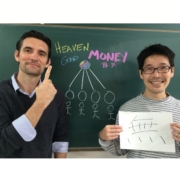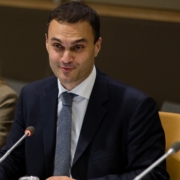Borhene Chakroun
Mobilizing Investment in Education
Earlier this year, UNESCO held a high-level segment of its Global Education Meeting aimed at galvanizing political commitment towards mobilizing investment in education. The goal was to encourage countries to develop strong domestic systems to fund education.
My guest today is Borhene Chakroun, Director for Policies and Lifelong Learning Systems at UNESCO. He has been working with UNESCO to spearhead the effort to bring conversations about financing education to the highest levels of the international community.
Citation: Chakroun, Borhene, interview with Will Brehm, FreshEd, 264, podcast audio, November 29, 2021.https://freshedpodcast.com/chakroun/
Will Brehm 1:56
Borhene Chakroun, welcome to FreshEd.
Borhene Chakroun 1:58
Hello. Thank you, Will.
Will Brehm 1:59
So, can you tell me a little bit about how COVID has impacted the financing of education worldwide?
Borhene Chakroun 2:06
I think, first of all, we need to say that we are facing a major crisis that is impacting every part of the education system as it is impacting economies, lives, and health of people. But education has been impacted directly because we have seen a closure of all education systems all over the world. 1.6 billion learners have been affected. And it’s important that we give attention to what will this take to get us back to normal or to get us back better. Is education financing impacted by the crisis? We have a rather nuanced perspective. We have evidence that education financing is being impacted in a mechanical way. In the sense that public expenditures are shrinking in education budget, which is in most economies, the largest is being impacted. At the same time, we have seen countries allocating resources to education through the stimulus packages. But this is not the situation everywhere. In most cases, these are high income countries, middle income, but for low- and lowest-income countries, we know that the stimulus packages are either thin or they don’t exist. And that means that educational financing is being impacted. And we have to look very closely on what does that mean in terms of the quality of education, in terms of equity of education, and in terms of the status of teachers, who in some of the education systems are the largest part of the budgets.
Will Brehm 3:35
Right. Okay, so teachers take up a huge amount of recurrent expenditures pretty much in all systems. The COVID pandemic has impacted education in middle- and high-income countries, they might have seen some stimulus money going into education as in other sectors as well with the stimulus packages. And then in low-income countries, we don’t see those same stimulus packages, and we see a general decline in education financing. Before we move on. I mean, with the stimulus packages, are nation states investing a lot of the stimulus money into education? Or like what percentage of stimulus money is going to education?
Borhene Chakroun 4:15
We have been watching very closely the stimulus packages and how much resources are allocated to education in this context. The data we have shows that 3% of the resources allocated to the stimulus packages are allocated to education. Of course, this is the reality at the average but then we can have differences across countries. And when it comes to middle- and low-income countries, the average is less than 1%. When you compare this to the importance of the education budget in the public expenditure, you see that it’s rather a thin part of the resources that are allocated to education.
Will Brehm 4:53
It’s quite surprising in a way. I had no idea. And in terms of, in general, education budgets before COVID, did we see a similar decline in public expenditures, which would naturally impact education? Or was it sort of a different trend that we noticed?
Borhene Chakroun 5:10
No. It was a rather different trend. Let me recall that in 2015 globally, we have adopted benchmarks that all member states are expected to align to. Having 4 to 6% of the GDP allocated to education, or 15% to 20% of the public expenditures allocated to education. And the objective was also that member states will meet the two benchmarks. We have seen that some countries, particularly low-income countries, have been investing more in education and trying to reach the benchmarks. But we were still far from having member states meeting those benchmarks. And when we look at the data, we found that around 47% of the countries are not meeting the benchmark related to the GDP. And others are not meeting the public expenditure benchmark.
Will Brehm 5:59
Wow. So, 47% of countries not meeting this GDP benchmark. That seems quite high and a bit worrisome. So, in a way, what impact has this sort of underinvestment in education had, particularly in low- and middle-income countries?
Borhene Chakroun 6:17
I mean, the impact is very clear. It’s that we are lagging behind in achieving the SDG 4 in different targets. And it’s a reality. The last report shows that we are not meeting the different targets. And obviously, it has an impact on the quality of the education itself. And again, we have evidence that many students are not reaching the proficiency level that they are expected to reach in terms of reading or numeracy. And we have a high dropout rate when it comes to secondary education, for example. So, basically, the lack of resources translates into lack of quality, lack of equity of the education system, and it translates into not meeting the SDG 4 goals.
Will Brehm 7:01
Okay. So, before COVID, there was, in a sense, underinvestment in many countries in education. And then during COVID, it sort of made this underinvestment potentially even worse. And in many ways, I mean, do countries now need to, like invest even more money to sort of overcome some of the shocks that COVID enacted or brought into a lot of education systems?
Borhene Chakroun 7:23
Will, there are a few points I think that are important here. One is when in some of the economies, 97% or sometimes 90% of the budget is allocated to teachers. Obviously, most of the countries have been trying to protect the teachers’ salaries. That means that the tiny part that was allocated to investment in pedagogical resources, in infrastructure, is missing. So, that’s the first point that we have to consider is that while probably the resources allocated to teacher salaries are maintained, all what would have contributed to improving and to scaling the access or quality or equity would not be there. The second aspect that is important is that the investments that are being done now on education will determine the quality and the future of the societies, the futures of economies. So, if we are investing less today that will be impacting the future. And the last piece, I think, is very important to consider that it’s not, particularly for low-income countries, it’s not only the domestic resources that are shrinking. Potentially, the development aid is also shrinking. And that would mean less resources allocated to education in those parts of the economies and parts of the world.
Will Brehm 8:36
So, given that situation that you’re describing, how can more funding be mobilized, right? I mean, in what way can nation states, particularly low- and middle-income countries, begin to mobilize additional funding to in a sense, “properly” finance education systems? And when I say properly, it’s related to, sort of, the commitments in SDG 4, which is what? 20% recurrent expenditures on education, or 4% to 6% of GDP spent on education. How might nation states go about properly funding their education systems?
Borhene Chakroun 9:11
I think here we have to think short term and long term. In the short term, obviously, the countries have to leverage those investments that are going, for example, in stimulus packages. Even if they are not large, but it’s about allocating resources in the stimulus packages and using them efficiently and equitably. That’s in the short run. In the long term, obviously, we are expecting member states to meet the benchmark or to go beyond the benchmark. And there is no silver bullet here. And there is no miracles. The question is: how much resources are we allocating, particularly from domestic funding? And the solution is about reforming the fiscal system and ensuring that there is more revenues for the public expenditure, which can then translate in more resources for education as part of the tradeoffs in the government’s decision. And this is an important aspect, Will, is that it’s the whole of government approach. It’s not only ministries of education. Ministries of education and ministers have to engage with the Minister of Finance, have to engage with Minister of Economy, and at the end of the day, it goes to head of governments to make the right tradeoffs. And our call, and our voice is very bold on this. We need to have more resources for public expenditure, and we have to have more resources allocated to education in that broader perspective.
Will Brehm 10:28
So, in a way, it would be something like the government spends a certain amount of money, and perhaps the government might be able to reallocate some money it spends on the military to fund education, right? There might be -instead of increasing the total pie of government expenditures, they actually could reallocate in some way to have a different distribution that emphasizes education on the one hand. On the other hand, they still might be able to grow the pie of the total expenditures through things like taxation, perhaps.
Borhene Chakroun 10:56
Absolutely. I think the question is, first of all, are you able to grow the pie? And that’s about a fair fiscal system, that’s about looking at the fiscality. But then the second is, are you making the right tradeoffs? And are you allocating to education rather than to military? or to other sometimes, resources or expenditure that are not the ones that we are driving for? Of course, it’s about education, it’s about health, it’s about equitable financing of education itself within the education system. Where are the resources going? And are we targeting the right target groups in terms of the ones that are disadvantaged, the ones that are not benefiting from the investment in education?
Will Brehm 11:37
How can states do that? Like, in a sense, how can states be more effective in the allocation of education resources?
Borhene Chakroun 11:44
First of all, there is an important aspect that if a country is not committed to the right to education, and its policy, and its legal framework, then we are missing the framework for it. So, that’s one first aspect. The second is addressing the challenges of the system, and particularly keeping an eye on the most disadvantaged. That could be, for example, rural versus urban, it could be a gender dimension, it could be minorities, that could be disabled persons. So, the contexts can differ, and the question is, are we taking an equity lens while planning the expenditures? Or are we taking a different lens which is responding to other lobby or other, I call it, push from different stakeholders?
Will Brehm 12:29
And from UNESCO’s point of view, how can nation states begin to think through some of these tradeoffs? You know, in the example that we’ve said earlier between the military and education? I mean, I would imagine it must be very hard to convince a nation state to reallocate some of their funding on the military and national defense to something like education. How can nation states start to lobby in a sense, that internal reallocation that might be needed to properly fund education?
Borhene Chakroun 13:01
I think we need to take it from another perspective. First of all, we need, as a global community, to be vocal and advocate for the right education, for the right trade-offs in particular, when it comes to education. And use the right arguments as well. I think it’s very important. The second is, how are we able to mobilize the national stakeholders? Just to give you an example. For example, we work with civil society. And civil society is important to mobilize because they can be vocal, they can mobilize the public opinion. And third is about the peer learning and capacity building. It’s not necessarily that countries are not willing to do. Sometimes they’re missing the capacities to do the right analysis. And it’s about evidence. For example, what data exists? How can we use this data to advance this agenda? And at the end of the day, it’s about the political commitment. And our role is to collect the data and show where we are going and make that international support and international pressure, if I can use the term, to put the policymakers in their responsibilities and to ask them to be accountable and responsible for their decision. In front of their public and their citizens first, but also in the international arena as well.
Will Brehm 14:15
Do you think COVID-19 then in that sense, could be seen as an opportunity to sort of advocate nation states to think slightly differently about how they fund education?
Borhene Chakroun 14:26
To be honest, we have seen that countries where there is a political commitment to education, we have seen them, for example, acting to reopen schools safely when they can reopen. To close schools at the last moment because they know that closing schools has an impact on the quality of learning, the equity, but also it has other impact on the well-being, on nutrition, on health. So, I think it’s first of all a political commitment that has to be clearly taken at the country level. But our role at the international level is to say education has been impacted. For example, we are publishing a report with the World Bank and UNICEF on the learning losses. And we know that the learning losses are real, but they’re unequal. And it’s very important that we raise the flag that this will require investment in terms of infrastructure, in terms of teacher training, in terms of programs for the well-being, in terms of educational resources, investing in the resilience of the education system. We are not at the end of the crisis. And when you see the data, you see that the COVID is continuing. We have still millions of learners who are out of school. And we know that more than half of the 1.6 billion learners didn’t have access to online learning because they didn’t have access to internet or they didn’t have access to devices.
Will Brehm 15:43
So, during that crisis -in that ongoing crisis, in many ways- you said that in the short term, nation states need to think about certain stimulus money to, sort of, you know, shock the system, and actually invest a huge amount of money up front to sort of help overcome this crisis. How can low- and middle-income countries, sort of, pay for a stimulus, right? I mean, is it about taking out more debt to be able to fund social sectors like education? Is that sort of the idea here?
Borhene Chakroun 16:12
Yeah, Will. It’s an important question that’s quite sensitive. Of course, the more economies are indebted, of course, the more they will have difficulties to get loans. And the higher is the cost of loans. But I think the message is, it’s a once in a generation investment that will be done now. One is, when there is resources allocated to recovery, that education is at the center of that because it’s about investing in the future. The second is that whatever budget was allocated to education, it has to be protected so that it doesn’t harm the situation, which was already not very good. And we had the crisis before the crisis in reality. And the third is, what innovative financing can we consider at the country and at the global level. Let me give examples. We have seen communities mobilizing resources to invest in education, we have seen foundations, we have seen the private sector as well, in some countries. So, that multi-stakeholders’ mobilization for education is an important action to be taken. The second is most economies are taking debts now to invest in the stimulus, in recovery. It will be a bit strange that we are saying for some economies, “Yes, it’s open bar. Take money and invest in recovery”. And for others we are telling them “No, no. Your debt is high. Stop! You will have to just live with what you have”. I think we have to have a coherent message. But again, I’m not a macro economist here. And I wouldn’t make receipts. But I think we have to have a coherent message. And the coherent message that investing in education and health is investing in the future. And that message has to go, and it is valid for advanced economies but also for low-income countries.
Will Brehm 17:53
How does overseas development assistance, or bilateral aid fit into this picture -particularly in the short term? You know, the idea of sort of adding stimulus money focused on education? How does ODA fit in?
Borhene Chakroun 18:08
We are updating the data on the ODA and probably, it will be available early next year. So, I think we have less data. Let me put it this way to be positive: we have seen international solidarity. We have seen countries who tried to work with and support other member states. Ourselves, we launched the Global Education Coalition that has a name to leave no one behind and to ensure learning never stops. We have seen also, a large movement with our colleagues at the World Bank, UNICEF, and the Education Commission. In the bilateral with the European Commission as well. We have seen a lot of mobilization to support particularly low-income countries. The question is: that’s a tiny part of the investment in education, we know. It’s less than 3% of the investment in education. So, the bulk will have to come from domestic financing. And that means to your first question, Will, is there a political commitment? What are the tradeoffs? And what are the parameters that are used for the tradeoffs? And the parameters, from our point of view, has to be about rights. It has to be about human centered recovery. And it’s about the right to education. And we have more than 100 countries that ratified the Right to Education Convention. It’s binding. They have to respect those commitments. And the right to education comes with a price. It’s not for free. It comes with investment that has to be done and the countries who are not investing in education are not investing in the right to education.
Will Brehm 19:34
But that sort of insight, and that argument would be valid before COVID as well. As you said, 46% of countries were under investing in their education systems in terms of not meeting that 4% to 6% of GDP. And those legal obligations of the right to education pre-exists COVID as well. And so, I guess the question is about how is it going to be any different in 2021 now that COVID has happened? I mean, should we really expect that countries will really begin to increase the funding to education and begin to act differently, in a sense? As a skeptic, what evidence do we have to think that they’re really going to act differently going forward?
Borhene Chakroun 20:14
You’re right. In reality, the COVID amplified the injustice and the challenge that we were facing. So, it’s not a vector of relief, or for improvement. So, it is amplifying, it is accelerating, in some cases, the inequities that we have seen in education systems. In most countries, we have seen a mix of technology that has been used, for example, for learning and teaching and learning. Radio, TV, and online. But in many economies, and many countries, access to online learning has been very limited. So, we know that this will impact education, and the quality of education, and equity. Now, what is changing? First of all, there are some good indicators, and I would like to be positive in this case. One is that never before have we discussed the issues of fiscality in the education context. And we have the Paris Declaration that was adopted by member states. It’s an opening to look more seriously about how the fiscal system is functioning in every country, and where the resources can be raised from the domestic financing. I think it’s a very important message from the international community but also from member states. And we had heads of states joining the event. So, I think that’s one important indicator. The second important indicator is that even where there are less resources, the stimulus packages, there is an attention to education in the stimulus package. And that, I think, is a positive indicator. Usually, the economic recovery will be more for companies, for investment in infrastructure. So, there is an opportunity. And the question is how can we use those resources in an efficient way? in an equitable way? And the third, I think there is a conscious change in the perspective related to how we can address the equity and how we can address SDG 4 agenda. That is coming from, for example, when you meet with ministers, and we had our General Conference just ending and we met with many ministers. We have heard a lot of attention, for example, to teachers, and to the quality of teachers, and how to invest in teacher training and professional development. We have heard a lot of attention to building resilience, including the digital transformation of education. So, there is this awareness about the importance of investing. How then does this translate into more resources? I think it’s again, the national agenda that has to drive. Our role as the international community is to raise the flag, to provide the evidence for it, provide the data for it, and it’s the national drive that has to take this forward.
Will Brehm 22:49
Yeah. It does sound like there’s this window that has been opened. And there’s a big discursive change at the international level about trying to increase domestic financing for education. And that is a really welcome change, in a sense. So, hopefully, that translates into changes at the national level going forward. I guess, you know, another big issue when it comes to education financing, particularly in low- and middle-income countries, is the amount of resources that households spend on education that sort of doesn’t get captured in that national accounting level. So, how should we begin to make sense of these high rates of household expenditures on education?
Borhene Chakroun 23:32
Absolutely. Let me nuance a bit here. You have to reconcile the community investment. Let me give an example. In a country like Chad, 60% of the schools are community schools. And community schools are schools that are funded by the community. The teachers are hired, and they are taken by the community. So, the community, the households are already investing in some parts of the world, of course, a lot in education. The problem comes with the quality of the learning in some cases because the community schools require more support, they require more attention from government. And we have seen that there is more attention from some ministers towards this but there is less attention to it when it comes to, for example, regulation, because it is a sensitive dimension. Now, there are some countries that are doing well. And let me give an example. For example, a country like Madagascar, which is a low-income country. There is an attention toward cash transfer to the poorest households so that they are supported, for example, for the nutrition, for access to education. We know from Brazil that the conditional cash transfer can bring kids to school and can ensure more sustainable financing for education, particularly for the poorest households. So, I think there are policy solutions and policy measures that exists that can work. Again, it’s the political will to make them happen and to drive them towards implementation and outcomes.
Will Brehm 25:05
It’s an interesting phenomenon, that household costs, because in a way, it’s sort of like a de facto tax, right? It’s a tax that sort of happens at the local level for schools that are in your area, even if it’s not being done by some nation state. And in a way, it really does show the commitment that families have for education, and they’re already spending a huge amount of money. And it’s just that issue of, should it be sort of centralized at a bigger level? And I can imagine some countries might have problems administering a tax system like that. And maybe some people wouldn’t feel comfortable giving money over to a tax system because it might never get redistributed back to their local school. So, it’s a really, as you said, delicate. It really is this delicate phenomenon. I mean, the other one that always comes up is, what are these households spending on for education? And often it is that private tutoring. That shadow education, right? So, it’s not even going into mainstream schooling. So, it’s a really complex problem, I would imagine. And it’s going to have to be sort of addressed in parallel with this focus on domestic financing as well.
Borhene Chakroun 26:13
Sure, Will. I mean, we have developed a tool that we piloted in several countries. We call it the National Education Account. And it’s a way to capture all the spendings on education. Not only the public expenditure, it captures also -because in some countries, education is under different ministries. And in some countries, some of the expenditures are not captured, including the household. So, we developed this tool and we piloted it in some countries. I think the question is how we can collect the right data to map these different expenditures and map where the money is going. Is it going in furniture, is it going in textbooks? Because in some countries, this is an investment that is made by household. And what is, I would say a paradox -if I can say so although it has an explanation-, in high income countries, the expenditure on education is taken by the states. I mean, a country like, in France, the textbooks are covered by the states. In the beginning of the academic year, the government gives an allowance to households to spend in the start of the year. When you go to low-income countries, it’s the household that will pay. You don’t have a free access to education. So, the household will pay for fees, they will pay for textbook, they will pay for transport. And of course, there is an explanation, it’s that in high income countries, the fiscal system, families are already paying through fiscality, while in low-income countries, the fiscal system is still rather weak. And obviously it has a different shape. But it’s important to highlight that there is this paradox, it’s that a family in a high-income country will have probably less direct expenditures on education compared to a family in low-income countries.
Will Brehm 27:58
It is a very strange paradox in a way. And I guess it highlights the reason to focus on developing fiscal states and a real emphasis. So, in terms of UNESCO’s effort to work with nation states to improve fiscal states, what’s next? Where are we going to try and put forward this effort?
Borhene Chakroun 28:20
Right. We are going into three, I would say, areas of work. The first one is documenting the promising practices and what works. I mean, there are different experiences. We have seen some countries earmarking for example, tax to education. This is not something that the fiscal experts will recommend but still, this is something that works in a country like Ghana, in a country like India, and in Nigeria. So, there are experiences that we would like to shed light on and learn from and bring that knowledge and experience to member states. Second, through the Paris Declaration, there is a commitment toward looking at the fiscal system. And we will be working under the global cooperation mechanism to look at how we can advance this dialogue between education, finance, and economic, and the whole of government approach. And this is a work that we’ll be doing. And third, we will be, and we are collecting data and watching how much resources are going to education, both in terms of GDP and public expenditure. But our eyes are open on the stimulus packages. We looked at how much resources, we looked at the measures, and now we’ll be looking at where the resources are located, how they use it, and what is the outcome? As I said, it’s an important aspect of the work we are doing. Maybe a last piece of work is that this is a collaboration between UNESCO and other organizations. It’s part of the inter-agency collaboration, and we would like to take this collaboration including with the civil society in the event we are invited, for example, a representative of the civil society who are looking at those aspects. There are networks that are looking at fiscality and fair fiscal systems, looking at fiscality and education. So, we would like to continue this dialogue. The expertise is not only with UNESCO. UNESCO will convene and will mobilize the expertise that is over there.
Will Brehm 30:18
Well, we look forward to seeing what UNESCO and these other agencies and civil society does when it comes to fiscal systems in education. Borhene Chakroun, thank you so much for joining FreshEd. It really was a pleasure to talk today.
Borhene Chakroun 30:30
Thank you for the invitation. Have a nice day.
Want to help translate this show? Please contact info@freshedpodcast.com
Related Resources
2021 Paris Declaration on education investments
2021 Global education meeting outcome document
Global Education Coalition
The Education Commission
National Education Account
Government expenditure on education as percentage of GDP
GEM report on education finance
The impact of the COVID-19 pandemic on education financing
Who pays for what in education?
Methodology of national education accounts
Education and training: Not yet prioritized in national fiscal responses
Uneven global education stimulus risks widening learning disparities
COVID-19 and options for financing education
Accelerating progress of low-income countries towards the SDGs: Post-COVID-19 world
Roadmapping new impact bonds in a Post-COVID world: Insights from case studies in Education
Financing primary and secondary education in sub-Saharan Africa
Financing education: Why should tax justice be part of the solution?
Multi-stakeholder aid to education: Power in the context of partnership
Have any useful resources related to this show? Please send them to info@freshedpodcast.com









